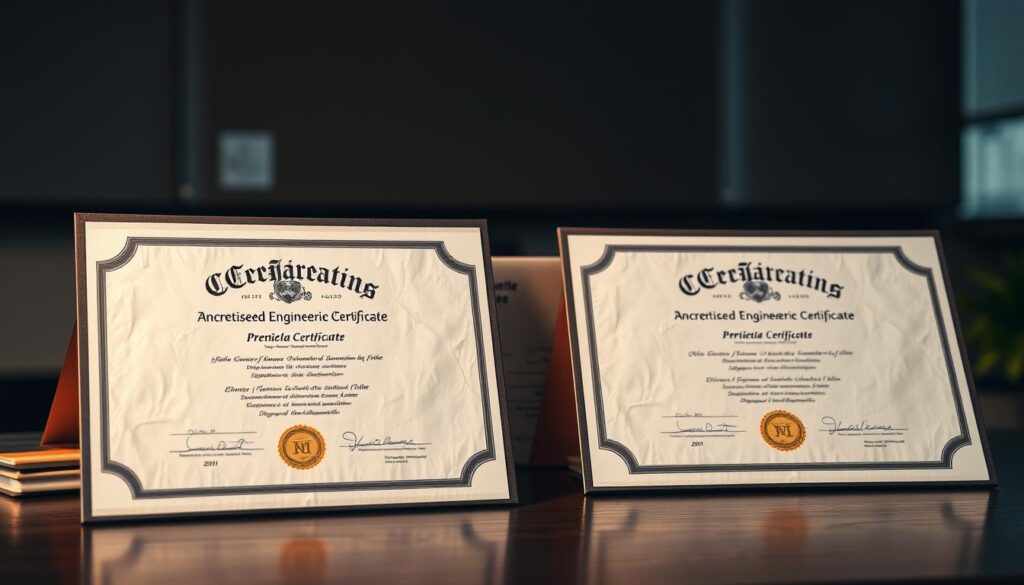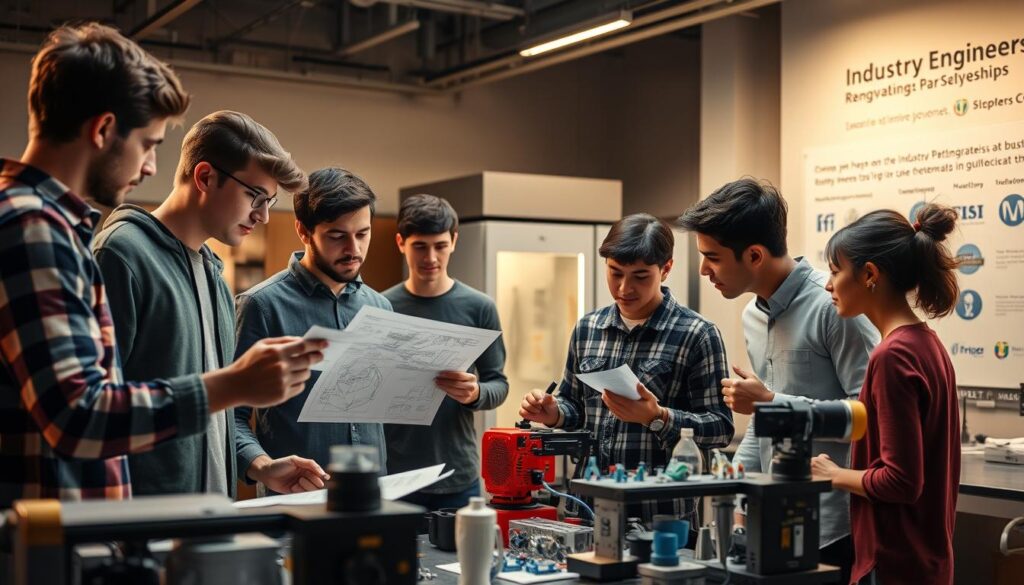Did you know that by 2025, the global STEM workforce is expected to grow by 13%? This surge underscores the critical role of engineering education in preparing the next generation of innovators.
As industries evolve, it’s essential that future engineers are equipped with the necessary skills and knowledge to tackle modern challenges. STEM disciplines form the foundation of this education, fostering a culture of innovation and creativity.
The importance of engineering education lies in its ability to shape tomorrow’s innovators, enabling them to drive technological advancements and solve complex problems.
Key Takeaways
- The global STEM workforce is expected to grow significantly by 2025.
- Engineering education is crucial for preparing students for modern challenges.
- STEM disciplines foster innovation and creativity.
- Engineering education shapes tomorrow’s innovators.
- Future engineers must be equipped with necessary skills and knowledge.
Understanding the Importance of Engineering Education
In an era of rapid technological advancements, engineering education is more critical than ever. As the backbone of innovation, engineers play a pivotal role in shaping the future of our society.
The Role of Engineers in Society
Engineers are instrumental in developing solutions to real-world problems, from improving infrastructure to creating sustainable energy sources. According to the National Center for Biotechnology Information, engineers contribute significantly to societal progress through their work in various fields.
The impact of engineers is evident in the development of life-changing technologies and infrastructure. For instance, advancements in medical devices, transportation systems, and communication networks are all driven by engineers.
Promoting Problem-Solving Skills
One of the key benefits of engineering education is the development of problem-solving skills. Engineering students learn to approach complex problems methodically, breaking them down into manageable components and applying theoretical knowledge to find practical solutions.
This skillset is invaluable in today’s fast-paced, technology-driven world. As noted by experts, “the significance of engineering education is more critical than ever” in preparing students for the challenges they will face in their careers.
“The goal of engineering education is not only to impart technical knowledge but also to foster critical thinking, creativity, and collaboration.”
Bridging Theory and Practice
Engineering education is unique in its ability to bridge the gap between theoretical knowledge and practical application. Through lab work, projects, and internships, students gain hands-on experience that complements their classroom learning.
| Theoretical Knowledge | Practical Application |
|---|---|
| Understanding of engineering principles | Lab experiments and projects |
| Mathematical modeling and analysis | Internships and co-op programs |
| Knowledge of materials and processes | Design and development projects |
By combining theoretical foundations with practical experience, engineering education prepares students for successful careers and fosters career opportunities in engineering. Moreover, it enhances engineering skills development, enabling graduates to adapt to evolving technologies and industry needs.
Key Components of an Engineering Curriculum
The key to a successful engineering education is a curriculum that integrates core subjects, hands-on learning, and interdisciplinary studies. An effective engineering program must provide students with a comprehensive understanding of fundamental principles, as well as the practical skills to apply them in real-world contexts.

Core Subjects in Engineering
Core subjects form the backbone of any engineering curriculum. These typically include mathematics, physics, and foundational courses specific to the engineering discipline, such as mechanical engineering, electrical engineering, or civil engineering. For instance, the Rutgers School of Engineering offers a comprehensive curriculum that covers these core areas, ensuring students gain a solid foundation in engineering principles.
Key core subjects include:
- Mathematics: calculus, differential equations, and statistics
- Physics and mechanics
- Materials science and engineering
- Electrical circuits and electronics
- Thermodynamics and fluid mechanics
Hands-On Learning: Labs and Projects
Hands-on learning is a critical component of engineering education, allowing students to apply theoretical knowledge in practical settings. Laboratory work and project-based learning help develop problem-solving skills, creativity, and collaboration.
Examples of hands-on learning experiences include:
- Lab experiments that demonstrate engineering principles
- Design projects that require students to develop innovative solutions to real-world problems
- Collaborative projects that simulate industry environments
Importance of Interdisciplinary Studies
Interdisciplinary studies are increasingly important in engineering education, as they enable students to understand the broader context in which engineering solutions are applied. By incorporating elements from other disciplines, such as business, social sciences, and humanities, engineering programs can foster a more holistic understanding of the impact of technology on society.
Benefits of interdisciplinary studies include:
- Enhanced understanding of the social and environmental implications of engineering projects
- Improved ability to communicate and collaborate with professionals from other fields
- A more nuanced understanding of the ethical considerations involved in engineering decisions
The Evolution of Engineering Education in the U.S.
From its inception to the present day, engineering education in the United States has adapted to societal needs and technological advancements. This evolution has been marked by significant milestones, innovative trends, and the integration of technology to enhance learning.
Historical Milestones in Engineering Education
The history of engineering education in the U.S. is replete with milestones that have shaped the discipline. The establishment of the first engineering schools in the 19th century laid the groundwork for modern engineering education. The Morrill Act of 1862 played a crucial role by providing federal funding for land-grant colleges that focused on agriculture and mechanical arts, thereby expanding access to engineering education.
As the 20th century progressed, engineering education continued to evolve, with significant advancements in fields such as electrical and chemical engineering. The post-World War II era saw a surge in engineering programs due to the demand for technological innovation. This period was characterized by a strong emphasis on research and development, setting the stage for the modern engineering curriculum.
Modern Trends and Innovations
Today, engineering education is characterized by a blend of traditional teaching methods and innovative approaches. The rise of online engineering programs has made it possible for students to access high-quality education from anywhere in the country. Institutions offering these programs, such as some of the best engineering colleges, have adapted their curricula to meet the needs of a diverse student body.
One of the significant trends is the incorporation of interdisciplinary studies, allowing students to combine engineering with other fields such as business or environmental science. This approach prepares graduates for a complex, interconnected world where engineering solutions must consider multiple factors.
“The future of engineering education lies in its ability to adapt to changing technological landscapes and societal needs,” said a leading engineering educator. “By embracing innovation and interdisciplinary approaches, we can ensure that our graduates are equipped to tackle the challenges of tomorrow.”
Impact of Technology on Education
Technology has revolutionized engineering education, offering new tools and methodologies that enhance the learning experience. The use of simulation software, virtual labs, and collaborative online platforms has become increasingly prevalent. These technologies not only make learning more engaging but also provide students with practical skills that are directly applicable in the workforce.
The integration of Artificial Intelligence (AI) and Virtual Reality (VR) in engineering education is another significant development. AI can personalize learning experiences, while VR can simulate complex engineering scenarios, allowing students to experiment and learn in a controlled environment.
As engineering education continues to evolve, it is clear that technology will play an even more central role in shaping the next generation of engineers. By leveraging these advancements, institutions can provide students with a comprehensive, relevant education that prepares them for success in their careers.
Accreditation and Quality Assurance in Engineering Programs
Accreditation plays a crucial role in ensuring the quality of engineering programs across the United States. It serves as a benchmark for evaluating the effectiveness of these programs in preparing students for successful careers in engineering.

Importance of ABET Accreditation
ABET accreditation is a critical factor in the quality assurance of engineering programs. It ensures that programs meet rigorous standards in terms of curriculum, faculty qualifications, and facilities. ABET-accredited programs are recognized for providing students with a high-quality education that prepares them for professional practice.
- Ensures curriculum relevance and rigor
- Verifies faculty qualifications and expertise
- Assesses facilities and resources
Standards and Best Practices
Accreditation involves evaluating engineering programs against established standards and best practices. These standards cover various aspects, including program outcomes, assessment methods, and continuous improvement processes. By adhering to these standards, institutions can ensure that their programs remain relevant and effective.
- Defining clear program outcomes
- Implementing effective assessment methods
- Fostering a culture of continuous improvement
Assessing Program Outcomes
Assessing program outcomes is a crucial aspect of accreditation. It involves evaluating whether students have achieved the desired learning outcomes upon completing their program. This assessment helps institutions identify areas for improvement and make necessary adjustments to enhance program quality.
Effective assessment methods include a combination of direct and indirect measures, such as exams, projects, and student surveys. By using a variety of assessment tools, institutions can gain a comprehensive understanding of program effectiveness.
Career Pathways for Engineering Graduates
With a strong foundation in engineering principles, graduates can pursue a wide range of career pathways that align with their interests and expertise. Engineering education not only equips students with technical skills but also fosters problem-solving abilities, creativity, and collaboration.
Diverse Job Opportunities
Engineering graduates can explore various job opportunities across different sectors. Some of the prominent roles include:
- Design and development engineer
- Project manager
- Research and development specialist
- Consulting engineer
- Systems engineer
These roles are available in industries such as construction, manufacturing, energy, and technology. For instance, a graduate with a degree in civil engineering can work on infrastructure projects, while a mechanical engineering graduate might be involved in designing innovative mechanical systems.
Emerging Fields in Engineering
The field of engineering is continually evolving, with new areas emerging due to technological advancements. Some of these emerging fields include:
- Renewable energy engineering
- Aerospace engineering
- Biomedical engineering
- Environmental engineering
- Robotics and automation
Graduates who venture into these areas can contribute to groundbreaking projects and innovations. For example, biomedical engineers are working on developing advanced medical devices and prosthetics.
Importance of Networking and Internships
Networking and internships play a crucial role in shaping the career of an engineering graduate. By participating in internships, students gain practical experience and exposure to real-world projects. Networking helps in building professional relationships that can lead to job opportunities.
According to industry experts, students who engage in internships are more likely to secure jobs upon graduation. For more insights on unlocking engineering careers, visit https://worldcivilsociety.com/engineering-careers-unlock/.
| Career Aspect | Description | Benefits |
|---|---|---|
| Diverse Job Opportunities | Variety of roles across different industries | Flexibility in career choices, potential for career growth |
| Emerging Fields | New and innovative areas in engineering | Opportunities for innovation, competitive edge in the job market |
| Networking and Internships | Practical experience and professional connections | Enhanced job prospects, industry insights, and mentorship opportunities |
The Role of Research in Engineering Education
Engineering education is significantly enhanced by the incorporation of research, providing students with hands-on experience and real-world problem-solving opportunities. This integration not only advances the field of engineering but also equips students with the skills necessary to excel in their future careers.
Innovative Curriculum Design
Incorporating research into the engineering curriculum is essential for keeping pace with the rapidly evolving technological landscape. By integrating the latest research findings into their courses, educators can ensure that students are exposed to cutting-edge concepts and techniques. For instance, a study on engineering education research highlights the importance of evidence-based practices in improving student outcomes.
Key areas of focus for innovative curriculum design include:
- Interdisciplinary approaches that combine engineering with other STEM disciplines
- Incorporation of real-world problems and case studies
- Emphasis on developing problem-solving and critical thinking skills
Opportunities for Student Involvement
Student involvement in research projects is a critical component of engineering education. By participating in research, students gain valuable hands-on experience, develop their critical thinking skills, and are better prepared for careers in research and development. As noted by a leading researcher, “Involving students in research projects not only enhances their learning experience but also fosters a culture of innovation and inquiry.”
“The best way to learn is by doing, and research projects provide students with the opportunity to apply theoretical knowledge in practical contexts.”
Opportunities for student involvement can be facilitated through:
| Opportunity | Description | Benefits |
|---|---|---|
| Research Assistantships | Students work alongside faculty members on research projects | Gain hands-on experience, develop research skills |
| Independent Projects | Students design and execute their own research projects | Foster independence, creativity, and problem-solving skills |
| Collaborative Research | Students work in teams on research projects, often with industry partners | Develop teamwork and communication skills, exposure to industry practices |
Benefits of Collaborative Research Projects
Collaborative research projects offer numerous benefits for engineering students, including the development of teamwork and communication skills, exposure to diverse perspectives, and the opportunity to work on complex, real-world problems. As highlighted in the table above, these projects can involve industry partners, providing students with valuable insights into professional practices.

By emphasizing the role of research in engineering education, institutions can better prepare students for successful careers in engineering and related fields. The integration of research into the curriculum, coupled with opportunities for student involvement and collaborative projects, is essential for fostering a culture of innovation and excellence.
Trends in Online Engineering Education
The landscape of engineering education is undergoing a significant transformation with the rise of online degree programs. As technology continues to advance, the way students learn and acquire skills is changing dramatically.
Growth of Online Degree Programs
Online engineering programs are becoming increasingly popular due to their flexibility and accessibility. According to a recent report, the number of students enrolled in online engineering programs has increased by over 20% in the past five years.
Key statistics:
| Year | Enrollment Numbers | Growth Rate |
|---|---|---|
| 2018 | 10,000 | – |
| 2019 | 12,000 | 20% |
| 2020 | 14,400 | 20% |
Benefits of Flexibility for Students
One of the primary benefits of online engineering programs is the flexibility they offer. Students can complete coursework on their own schedule, allowing them to balance academic responsibilities with work and other obligations.
“Online education has given me the opportunity to pursue my degree while continuing to work full-time. It’s been a game-changer for my career.” – John Doe, Online Engineering Student
Quality Concerns and Ensuring Standards
While online engineering programs offer many benefits, there are also concerns about maintaining quality standards. Accreditation bodies like ABET play a crucial role in ensuring that online programs meet rigorous academic standards.
To address quality concerns, many institutions are implementing innovative solutions such as:
- Virtual labs and simulations
- Interactive online coursework
- Regular assessments and feedback
By embracing these trends and addressing the challenges associated with online engineering education, institutions can provide high-quality programs that meet the needs of students and employers alike.
The Impact of STEM Initiatives on Engineering Education
Engineering education has witnessed a substantial transformation due to the impact of STEM initiatives. This change is largely driven by the integration of STEM disciplines into the curriculum, enhancing the quality and relevance of engineering education.
The involvement of both government and private sectors has been pivotal in promoting STEM initiatives. Government programs and private investments have supported the development of innovative educational programs, providing resources for students to engage in hands-on learning experiences. For instance, the STEM education journal highlights various successful initiatives that have improved engineering education.
Government and Private Sector Involvement
The collaboration between government agencies and private organizations has led to the creation of programs that support STEM education. These initiatives provide funding for educational resources, internships, and mentorship opportunities, thereby enriching the learning experience for engineering students.
- Government funding for STEM programs
- Private sector investments in educational technology
- Collaborative projects between industry and academia
Programs to Encourage Diversity
STEM initiatives have also focused on promoting diversity within engineering education. Programs aimed at underrepresented groups encourage a more inclusive environment, fostering a diverse range of perspectives and ideas. This diversity is crucial for driving innovation and solving complex problems.
Key strategies include:
- Scholarships for underrepresented students
- Mentorship programs pairing students with professionals
- Outreach initiatives to engage students from diverse backgrounds
Building Interest in Engineering Careers
To build interest in engineering careers, STEM initiatives have introduced various programs aimed at students at different educational levels. From elementary school to university, these programs highlight the exciting opportunities available in engineering.
Some effective approaches include:
- Hands-on engineering projects for school students
- Internships and co-op programs for university students
- Career fairs and industry events

The Importance of Professional Development for Engineers
The rapidly changing landscape of engineering demands a continuous commitment to professional development. As technology advances and new methodologies emerge, engineers must adapt to remain relevant in their field.
Lifelong Learning and Certifications
Lifelong learning is a cornerstone of successful engineering careers. Engineers can enhance their skills through various means, including graduate engineering programs and professional certifications. These opportunities not only deepen their technical knowledge but also broaden their understanding of industry best practices.
Certifications, such as those offered by professional engineering bodies, can significantly boost an engineer’s career prospects. They demonstrate a commitment to excellence and a willingness to stay updated with industry standards. For instance, a graduate engineer registration can open up new avenues for career advancement.
Industry Conferences and Workshops
Industry conferences and workshops provide invaluable opportunities for engineers to learn about the latest developments in their field. These events offer a platform for networking, knowledge sharing, and collaboration. By attending conferences and workshops, engineers can gain insights into emerging trends and technologies, helping them stay ahead of the curve.
- Networking opportunities with peers and industry leaders
- Exposure to new technologies and methodologies
- Professional development through workshops and training sessions
Mentorship Opportunities
Mentorship is a powerful tool for professional development in engineering. Experienced mentors can provide guidance, support, and valuable insights to less experienced engineers. This relationship can help mentees navigate their careers more effectively and make informed decisions about their professional growth.
By engaging in mentorship programs, engineers can benefit from the wisdom and experience of their peers. This not only enhances their technical skills but also fosters a culture of collaboration and knowledge sharing within the engineering community.
Innovative Teaching Methods in Engineering
The landscape of engineering education is evolving, driven by innovative teaching methods that enhance student engagement and learning outcomes. As the field continues to advance, it is crucial for educational institutions to adopt effective strategies that prepare students for the challenges of the modern engineering world.
Active Learning Techniques
Active learning techniques are being increasingly adopted in engineering education to promote a more engaging and interactive learning environment. These techniques include:
- Project-based learning, where students work on real-world projects to apply theoretical concepts.
- Collaborative learning, which encourages teamwork and communication among students.
- Problem-based learning, where students are presented with open-ended problems to solve.
These approaches not only enhance students’ understanding of complex engineering concepts but also foster critical thinking and problem-solving skills.

The Role of Technology in Teaching
Technology is playing a pivotal role in transforming engineering education. The use of Artificial Intelligence (AI) and Virtual Reality (VR) is becoming more prevalent, offering immersive learning experiences that simulate real-world environments.
These technologies enable students to:
- Visualize complex systems and processes.
- Experiment with different variables in a controlled environment.
- Develop skills that are highly valued in the industry.
Flipped Classrooms in Engineering Education
The flipped classroom model is another innovative approach being adopted in engineering education. This method involves reversing the traditional lecture-homework format, where students are introduced to course materials at home and work on activities and projects in the classroom.
This approach allows for:
- More personalized instruction and feedback.
- Increased student engagement and participation.
- Better utilization of class time for collaborative and interactive learning.
By embracing these innovative teaching methods, engineering education can become more effective, engaging, and relevant to the needs of the industry.
Challenges Facing Engineering Education Today
Today, engineering education confronts several critical issues that affect its quality. The rapidly evolving technological landscape demands that engineering programs adapt to changing industry needs. This adaptation is crucial for ensuring that graduates are well-prepared for the workforce.
Addressing Skill Gaps in Graduates
One of the significant challenges is addressing the skill gaps in graduates. Employers often report that while graduates have a strong theoretical foundation, they sometimes lack practical skills. To bridge this gap, many institutions are incorporating more hands-on learning experiences into their engineering curriculum. For instance, programs that include internships, co-op opportunities, or project-based learning can help students develop the practical skills that employers value.
Furthermore, institutions can benefit from collaborating with industry partners to understand the specific skills required in the workforce. By doing so, they can tailor their programs to meet these needs, thereby enhancing the employability of their graduates. Students can also explore accredited engineering degrees online, which offer flexibility and a comprehensive education.
Balancing Theory and Practical Experience
Balancing theoretical knowledge with practical experience is another challenge. While theoretical foundations are essential, practical application is equally important. Many engineering programs are now adopting innovative teaching methods, such as flipped classrooms and project-based learning, to achieve this balance. These methods allow students to apply theoretical concepts to real-world problems, enhancing their understanding and skills.
The integration of technology, such as simulation tools and virtual labs, also plays a crucial role in providing students with practical experience. These technologies can simulate real-world environments, allowing students to experiment and learn without the constraints of physical equipment.
Navigating Financial Constraints
Financial constraints pose a significant challenge to engineering education. Institutions must navigate budget limitations while maintaining the quality of their programs. One approach is to seek external funding through grants or partnerships with industry. Additionally, leveraging technology to offer online or hybrid programs can help reduce costs associated with maintaining physical infrastructure.
Despite these challenges, there are opportunities for innovation. For example, institutions can collaborate to share resources or develop open-source educational materials, thereby reducing costs. By adopting a proactive and innovative approach, institutions can navigate financial constraints while continuing to provide high-quality accredited engineering degrees.
Global Perspectives in Engineering Education
As the world becomes increasingly interconnected, the importance of global perspectives in engineering education cannot be overstated. Engineering students must be equipped to tackle challenges on an international scale, necessitating a curriculum that includes global perspectives and cultural competency.
Comparing U.S. and International Programs
The structure and focus of engineering programs vary significantly between the U.S. and international institutions. For instance, some of the best U.S. colleges for civil are recognized globally for their rigorous programs. In contrast, international programs might focus more on theoretical foundations or specific industry needs.
| Aspect | U.S. Programs | International Programs |
|---|---|---|
| Curriculum Focus | Balanced theoretical and practical training | Often specialized, with a strong theoretical base |
| Research Opportunities | Abundant research opportunities, including interdisciplinary projects | Varying research opportunities, sometimes limited by resources |
| Global Recognition | Highly regarded worldwide, especially for certain specialties | Recognition varies by country and institution |
Opportunities for Global Collaboration
Global collaboration in engineering education is on the rise, with institutions worldwide participating in joint research projects and student exchange programs. Northeastern University’s Global Perspectives in Engineering minor is an example of how universities are fostering global awareness among engineers.

The Importance of Cultural Competency
Cultural competency is crucial for engineers working in global teams or on international projects. It enables them to understand and navigate different cultural norms, communicate effectively, and manage diverse teams.
Key Benefits of Cultural Competency:
- Enhanced teamwork and collaboration across cultures
- Improved communication with international clients and partners
- Better adaptation to global work environments
By incorporating global perspectives and cultural competency into engineering education, institutions can prepare students for success in an increasingly globalized world.
The Future of Engineering Education
The future of engineering education is poised to undergo significant transformations. As technology continues to advance at an unprecedented rate, the way we educate engineers must evolve to keep pace. The integration of emerging technologies into the curriculum is crucial for preparing students for the challenges of tomorrow.
Predictions for Upcoming Trends
Several trends are expected to shape the future of engineering education. One key trend is the increased focus on interdisciplinary studies, combining engineering with other fields such as biology, computer science, and environmental science. This holistic approach will enable engineers to tackle complex problems that require a broad range of skills and knowledge.
Another trend is the growing importance of soft skills, such as communication, teamwork, and problem-solving. As engineering projects become more complex and collaborative, the ability to work effectively with others will be essential.
Integration of AI and Machine Learning
The integration of AI and machine learning into engineering education is revolutionizing the way we teach and learn. AI-powered tools can enhance the learning experience by providing personalized instruction, automating grading, and offering real-time feedback. Machine learning algorithms can help identify areas where students are struggling, allowing educators to target their support more effectively.
“The future of engineering education lies in embracing technologies that enhance learning and prepare students for a rapidly changing world.”
Preparing Students for a Changing Job Market
As the job market continues to evolve, engineering education must adapt to prepare students for the challenges ahead. This includes focusing on emerging fields such as renewable energy, cybersecurity, and data science. It also involves providing students with the skills and knowledge needed to be adaptable and resilient in the face of change.
- Emphasizing lifelong learning and professional development
- Fostering a culture of innovation and entrepreneurship
- Encouraging collaboration and teamwork
The Role of Industry Partnerships in Education
By partnering with industries, educational institutions can offer students a more comprehensive learning experience. This collaboration is essential for providing students with practical skills and preparing them for the workforce.
Benefits of Collaboration with Businesses
Industry partnerships bring numerous benefits to engineering students. They provide opportunities for students to gain hands-on experience through internships and co-op programs. According to a recent study, students who participate in these programs have a higher chance of securing jobs upon graduation. For instance, a survey found that 70% of interns receive job offers from their internship providers.
Moreover, industry partnerships facilitate the development of curriculum that is relevant to current industry needs. This ensures that graduates possess the skills required by employers, thereby enhancing their career opportunities in engineering. For more information on career opportunities, visit this resource.

Internships and Co-op Programs
Internships and co-op programs are integral components of industry partnerships. They provide students with the opportunity to apply theoretical knowledge in real-world settings. This not only enhances their understanding of engineering concepts but also develops their problem-solving skills.
A comparison of various engineering programs that include internships or co-op programs reveals that these students tend to have better job prospects. The table below summarizes the benefits:
| Program Type | Job Placement Rate | Average Starting Salary |
|---|---|---|
| Internship | 80% | $65,000 |
| Co-op | 85% | $70,000 |
| No Industry Experience | 60% | $55,000 |
Industry Advisory Boards
Industry advisory boards play a crucial role in ensuring that engineering programs are aligned with industry needs. These boards consist of professionals from various engineering disciplines who provide insights into the latest trends and technologies.
By working closely with industry advisory boards, educational institutions can develop curricula that are relevant and effective in preparing students for successful careers in engineering. This collaboration is essential for engineering skills development and for ensuring that graduates are well-equipped to meet the demands of the industry.
Inspiring the Next Generation of Engineers
Promoting STEM education is crucial for shaping the future of engineering. Outreach programs for K-12 students play a significant role in sparking interest in STEM disciplines. By engaging underrepresented groups and promoting community initiatives, we can foster a more diverse and inclusive environment in engineering.
Reaching K-12 Students
Effective outreach programs help students discover the exciting world of engineering. These initiatives not only educate but also inspire young minds to pursue careers in STEM fields. As a result, students are more likely to consider online engineering programs in the future.
Engaging Underrepresented Groups
Efforts to engage underrepresented groups in STEM education are vital for creating a diverse workforce. By promoting STEM through community initiatives, we can encourage more students to explore engineering careers. This, in turn, can lead to a more innovative and dynamic industry.
Promoting STEM through Community Initiatives
Community initiatives are essential for promoting STEM education. By working together, educators, industry professionals, and community leaders can create a supportive environment that encourages students to pursue engineering careers. This collaborative approach can help inspire the next generation of engineers.
